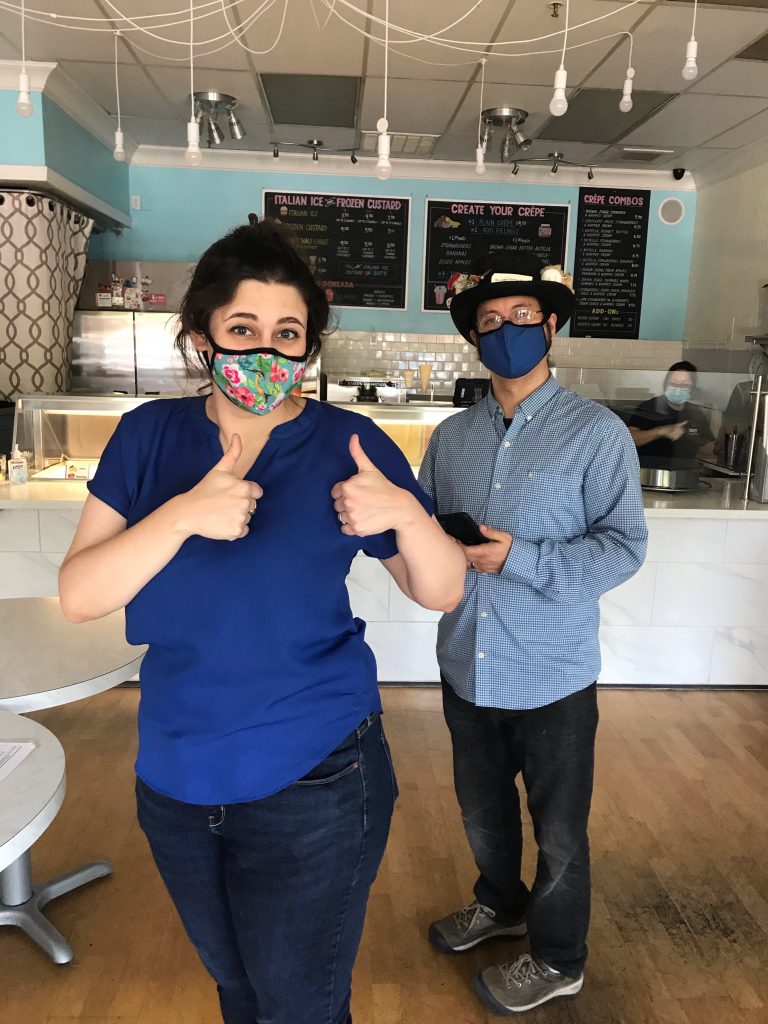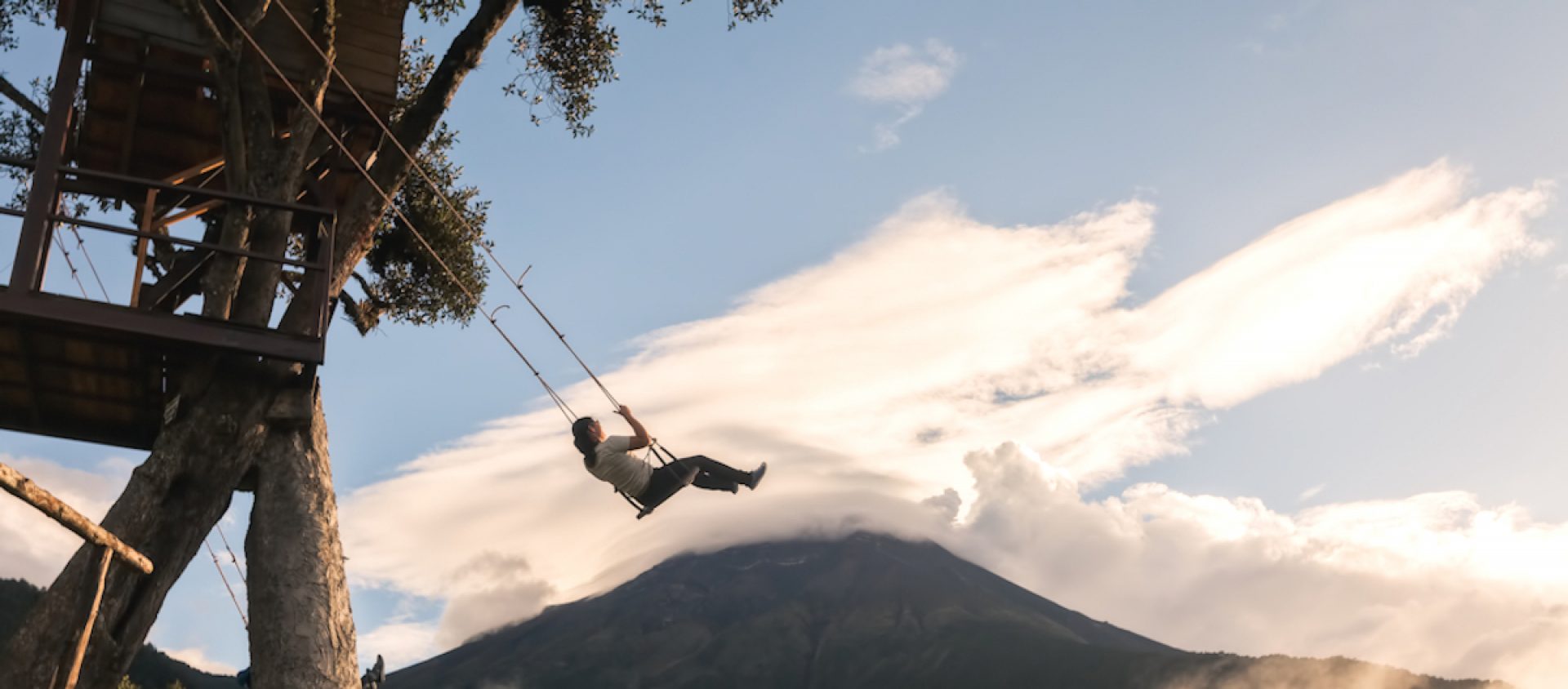Category: essays
Ponce Chronicles 2021, Part 4
I’ve made progress on the home repair project, here in Puerto Rico. I’ve constructed a small Quonset hut over the pump for the main cistern, a task left over from the last trip. Not elegant, perhaps, but for the last couple of years the pump and electric motor have been exposed to the elements, which can’t have been good. Now they’re snug and protected, more or less.
Before:
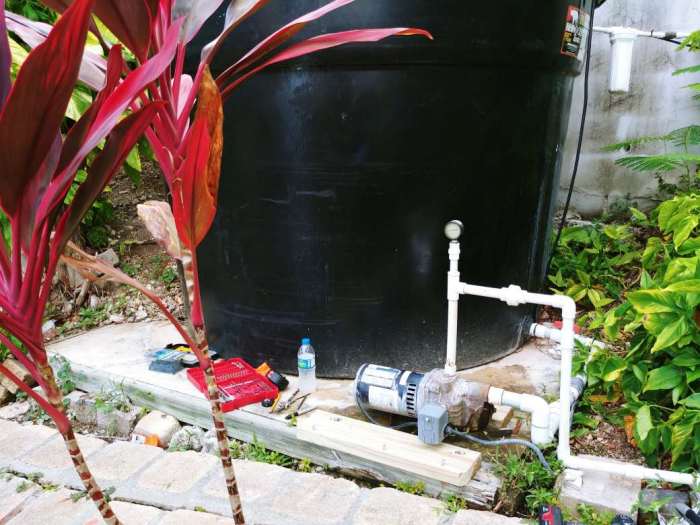
After:
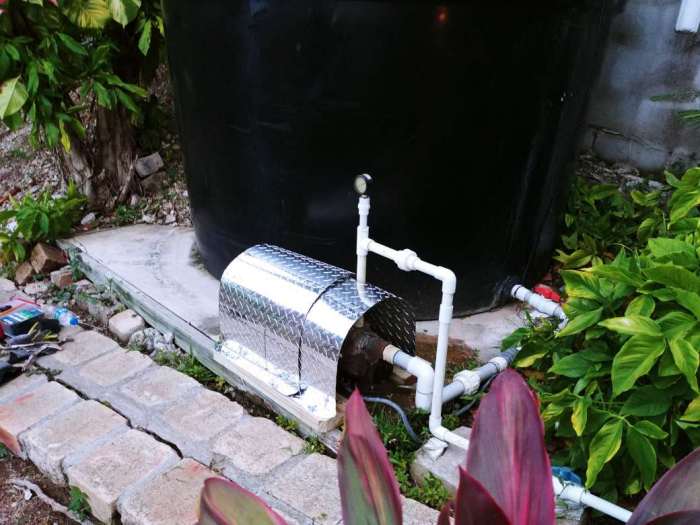
That, you’ll note, wasn’t on the to-do list I gave last time. There are many such things, and every one of them is going to take ten times longer than I estimate when I start it. Death, taxes, and ten times longer. You can count on it.
Remember the air conditioner I was working on? I got the frame installed around it. That took ten times longer, too. It doesn’t look good yet, so no picture.
Remember the pool deck I showed last time, in late-night mood lighting? Here it is, in daylight, close up. You begin to see the problem. They all have to be fastened from beneath. I estimate it will take… well, never mind.
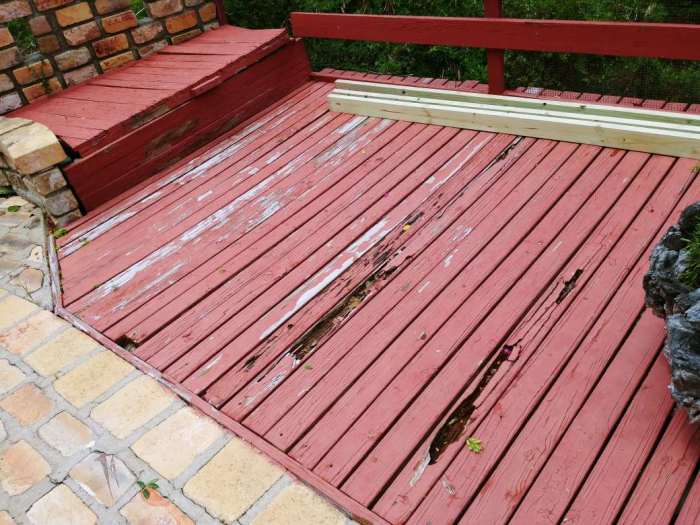
Foliage in Puerto Rico is glorious. Here, to brighten the mood, are some trinitaria and flamboyán behind the house.

Characters Hurling Insults For Fun and Profit
 How many times has a discussion escalated into an argument, or an argument into violence, with the hurling of insults? It seems we human beings never outgrow the impulse to call people who disagree with us nasty names. There have been enough compilations of creative, gleeful, or historical insults to fill entire libraries. We so much enjoy our own cleverness that we blithely ignore whether calling someone names actually encourages them to change their behavior or whether it firmly cements their own negative opinion of us and their determination to not do whatever it is we want. The words we use and the comparisons we make say as much about us as about those we are insulting. The same is true for characters in fiction.
How many times has a discussion escalated into an argument, or an argument into violence, with the hurling of insults? It seems we human beings never outgrow the impulse to call people who disagree with us nasty names. There have been enough compilations of creative, gleeful, or historical insults to fill entire libraries. We so much enjoy our own cleverness that we blithely ignore whether calling someone names actually encourages them to change their behavior or whether it firmly cements their own negative opinion of us and their determination to not do whatever it is we want. The words we use and the comparisons we make say as much about us as about those we are insulting. The same is true for characters in fiction.
Let’s accept as given that the purpose of insults is not reconciliation. If that were true, we’d have long since achieved peace in the Middle East, not to mention a few dozen other places around the globe. What are the other possibilities?
- Venting ill temper, including displaced aggression – that’s the man who kicks his dog instead of his boss, the real target of his anger.
- Showing off for a third party.
- Parroting what has been said by those the character respects.
- Being out of control. If violence is the last refuge of the incompetent, then surely hurling insults is an expression of frustration in a person who simply can’t come up with a constructive response.
- Trying to provoke a reaction, whether it’s loss of control in the other character or an escalation of violence.
- Justifying previous ill-treatment of the person being insulted.
Some of these motives are deliberate, calculated to evoke a specific response, but others are just the opposite. Assuming a character knows what he’s doing and does it on purpose, how invested is he in the result? He might get what he wants, but he might not. One of those two overgrown schoolboys taunting one another might turn the other cheek. Or might laugh in his face. What does your character do then?
The parallel to this is how a character reacts when she realizes she’s crossed a line, that she’s out of control, and that to large extent depends upon how self-aware she is. Some people are so embarrassed, they escalate hostilities, trying to get the other person’s response to justify their own lapse in judgment. Others will back off if given the opportunity, for instance if a third party steps in and lowers the tension. A character could realize what he’s done, lack the skills to remedy the situation, participate in whatever bad things happen next, and carry away a secret feeling of guilt for the outcome.
Then there’s the particularly (and often deliciously) odious character who is in perfect control of himself and hurls insults deliberately. The cruelty has a purpose, and if the character is challenged on his own behavior, he justifies it as being in the best interests of the person being insulted. “For your own good,” “to toughen you up,” that sort of thing.
Sometimes insults are a form of betrayal. Is this deliberate or unconscious? Heated words inflicted on a friend or loved one in the moment, without reflection on the hurt they cause? Even if the hurt is verbally forgiven, do the effects of a moment of ill-considered pique change the relationship? And how might the resulting resentment and guilt play out over time?
Now to flip the mirror and look at the character being insulted, who really is the person with the power in this situation. She has the greatest degree of freedom in her actions, whether to respond in kind or in some other way; whether to walk away, whether to draw out the suspense of the encounter; whether to end the exchange for good or let it fester – or encourage that festering. What is his history in the relationship and will he use the insult to settle an old score or will he refuse to take it personally – and why?
Therein lies a tale or twenty…
Ponce Chronicles 2021, Part 3
I’ve been here at Casarboles (Treehouse) in Ponce, Puerto Rico, a week and a half now, and it’s amazing how little I feel I have accomplished, despite feeling that I’ve done nothing but work. How can that be? All those trips to Home Depot, all that hardware purchased and wrestled around, all those damp, pressure-treated two-by-fours carried home in the little Kia rental car to be laid out in the sun to dry. Surely that counts for something.
Exhibit 1: Here’s the picturesque pool deck, photographed in a soft nighttime glow.
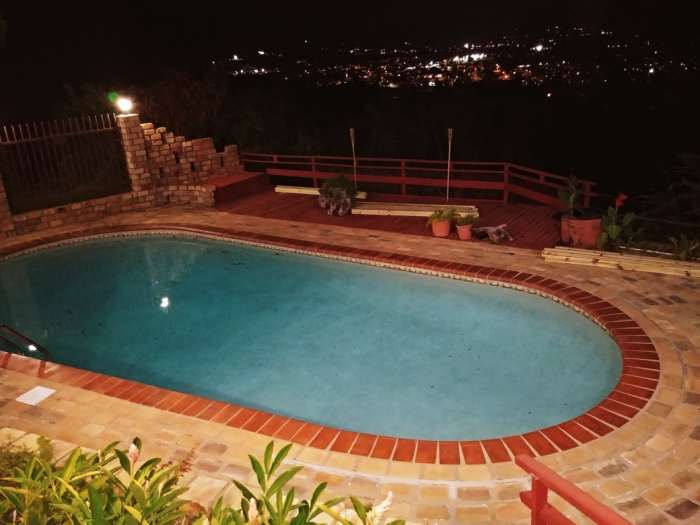
What you can’t see in the picture is that the whole thing needs to be replaced. Not the steel supports that Allysen’s dad built—they’re still solid—but all the decking, and all the railing. Since we can’t get anyone in our time frame to work on it, I’m afraid it’s my job. Hence all the two-by-fours. (Yes, I know I could order them and have them delivered, but I need to hand-select them to weed out all the warped, knotty, and split ones. Because they’re going to be decking and railing.) By the way, have you checked the price of lumber lately?! Anyway, that, I thought, would be my first big job. Except…
Exhibit 2: Jayce—in a laudable fit of cleaning and inspecting while she was here—discovered that the AC to the master bedroom was full of mold and ready for the junk heap. Well, no problem, I said, we’ll just replace it. Except that it wasn’t installed in a window. I had to chisel it, literally, out of a wall.

And then repair and build a new framework in the wall to hold the new, smaller unit.
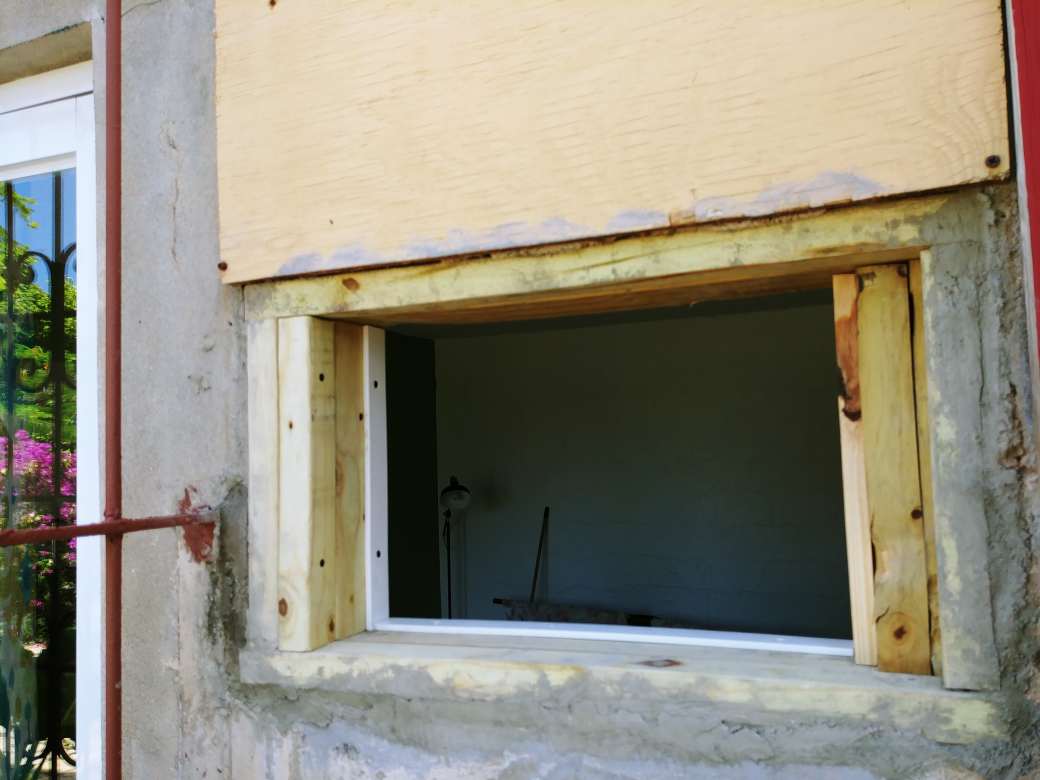
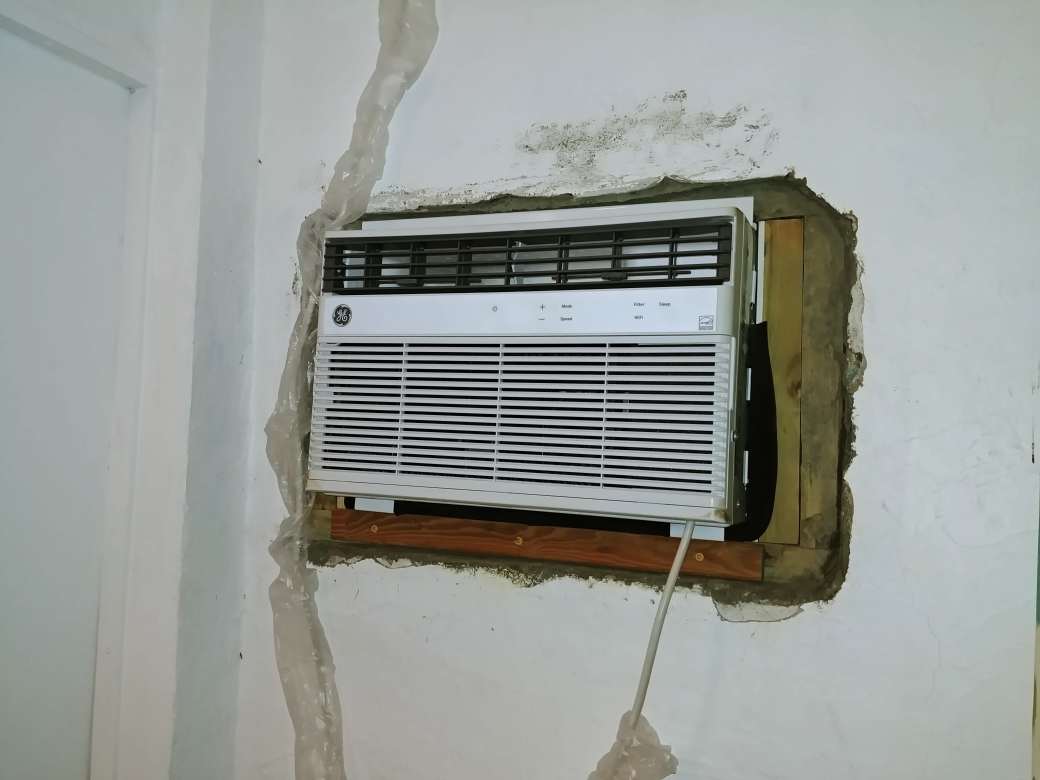
And then trim it all off so it looks good. Days later, I’m finished with the first two parts, just starting on the trim. To be followed by paint. Soon, I hope, we’ll be able to move into the room. If it sounds like I know what I’m doing or am particularly good at any of this, well, remember that I’m a fiction writer. One step up from a grifter.
Amidst this, my brain has been hard at work trying to figure out how to rebuild the pool pump cover, which was badly designed and has warped and fallen apart. And the once-solid gate to the “back forty,” which now solidly thunks on your feet when you try to lift it aside from where it’s propped because it fell off its hinges last year. Or how to set up a gauge and alarm on our water cisterns, which are just big, dumb black plastic tanks.
Yes, the city water went off for about two days, due to electrical problems involving the no-doubt ancient pumps pushing water up the hill. Our cisterns kept us supplied, but only barely, owing to the fact that the way one discovers that the water is off is when your cisterns run dry. In this case, it was Frances next door who ran out first and alerted us. Usually, it’s the reverse. Well, at least we had the pool to shower in. But the water’s back on now, and the tanks are full. (For now!)
During all of this, Allysen has continued to work her regular job during the day, remotely just as she did from home. She does her part on the house around the edges of that work, on the domestic side of things.
Much of what we’re doing would be necessary anyway, but are really necessary if we’re to keep renting the place.
Let’s close with a nice picture. Here’s Jayce and Allysen on the outdoor terrace of the Vistas restaurant.
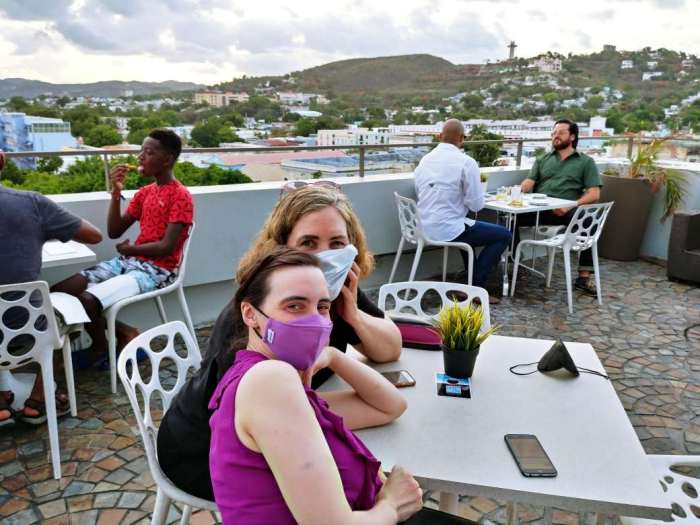
See that little (giant) cross up on the top of the hill? Our house is a smidge to the right of it. The best view of the ocean and the coast comes just as you are driving down the hill past La Cruceta (the cross).
Ponce Chronicles 2021, Part 2
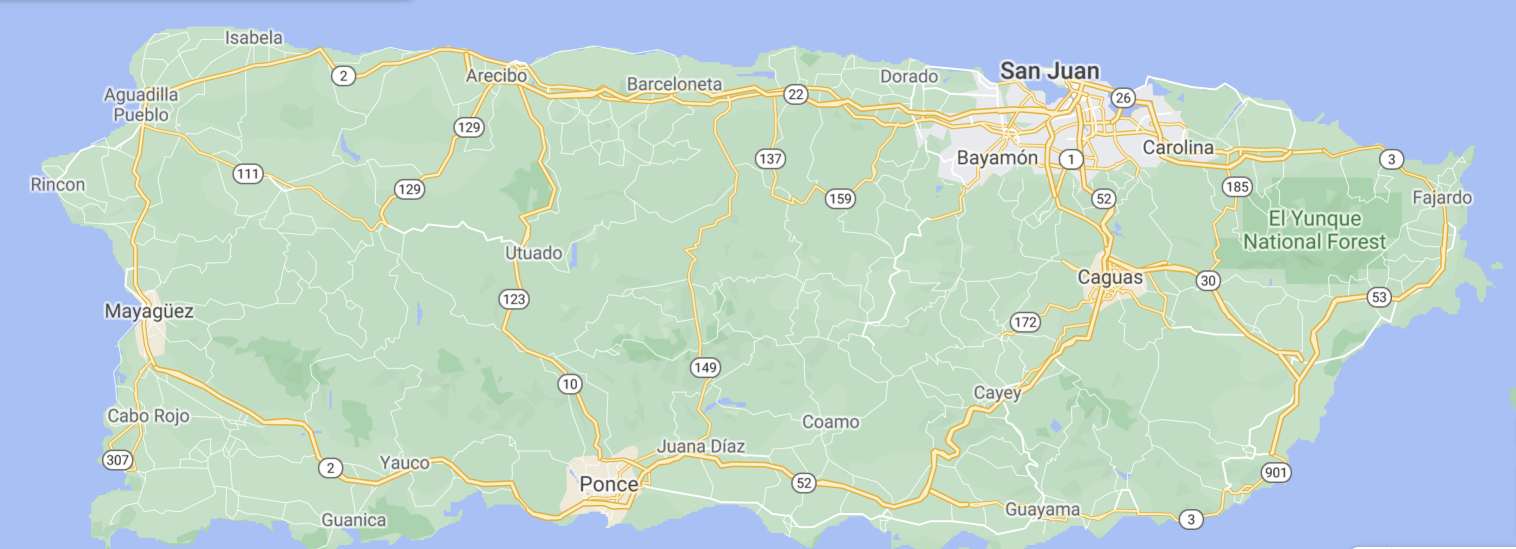
As I said last time, I dropped Jayce off at the San Juan airport today, to fly home. (She is, in fact, already home with the dogs!) Time was, we used to fly straight into Ponce from Boston, via NYC or Orlando. But those flights stopped with the pandemic, so now we have to come in through San Juan, a two-hour drive over the mountains. (Just as well, as it turns out, since there were no rental cars to be had in Ponce.)
This year’s car has a stereo unit that picks up your smartphone as soon as you plug it in to charge, and shows your phone’s GPS display on a larger screen. This would be great, except for the occasional lag in update of the display. Said lag (and poor road signage) has resulted in some missed turns and frustrating detours. Today, after dropping off Jayce, I headed to Costco, not too far from the airport. I sort of spiraled in, like a vulture looking for its next meal to give up the ghost. Eventually, this and that aligned, and I made it.
After stocking up with various consumables needed for the house, I paid and headed for the pizza area. I had never eaten Costco pizza, despite my brother-in-law Andrew’s long-standing testimony to its excellence, and I thought: The time has come. So I bought a slice. I liked it! I ordered a whole pizza to bring home and hit the road.
Now, ordinarily, the route from San Juan to Ponce is pretty much a straight shot over the mountains on the reasonably well-maintained highway, PR52. Due to ongoing construction, Google Maps told me I’d save 20 minutes by taking an alternate route: Route 1, winding through the mountains. Have you ever seen the Snake River from an airliner while flying across the U.S.? Wind and curl and curl and wind and loop. Serpentine to the power of 10. That’s PR1 through the mountains, except much narrower, with tight turns, back and forth. Fractal, like the Norwegian coast. Throw in a driver in a Corvette who seems desperately to want to pass the car ahead, and who treats the single yellow lane marker like the centerline of a runway. And the little beer joints on the righthand side of the road, from which cars randomly back out into traffic. It’s fun! I pass some private driveways that look like the first hill of Cedar Point’s Millennium Force*. I’m getting a taste of the mountains. Despite all this, the detour ends up cutting my projected drive time by half an hour. That must have been some backup on 52!
Arriving home, I put the pizza box on the kitchen counter and went to find Allysen. I came back a few minutes later to find one of the neighborhood stray cats up on the counter, pizza box open, scarfing the cheese off the top of the pizza. He got almost half of it before I chased him away. Testimonial to Costco pizza?
Now what do we do (humanely) about the influx of stray cats on the hill??
*The Millennium Force in Sandusky, Ohio, is my favorite rollercoaster! I’ve been on it just once.

Ponce Chronicles 2021, Part 1
This continues a series I began years ago, long before Treehouse Writers came together, about my family’s trips to work on a house we call Casarboles. Treehouse. It’s in Ponce, Puerto Rico. It will all be explained; just dive in. My entries here lag a bit behind in time, so when I say “today,” understand I mean “very recently.” Here goes…
Today I dropped my daughter Jayce off at the San Juan airport to fly back home to Boston after ten days of sweat and toil in the Puerto Rican sun. Okay, I exaggerate. She wasn’t actually out in the sun most of the time. But she did work hard!
But I’m getting ahead of myself. If you’re new to the Ponce Chronicles, Ponce is the second-largest city in Puerto Rico, where my wife Allysen’s parents built a home back in the 1970s. Sadly, her parents are no longer with us, so the home now belongs to Allysen and her brother. It’s a beautiful place, and popular among weekend vacation renters. It’s also a place that requires constant, intensive upkeep—which we’re not here most of the time to provide. So, usually, once a year, we come down to work on needed repairs. Sometimes much needed repairs, such as after Hurricane Maria and last year’s earthquakes. And this time, the pandemic. Not that Covid attacked the house. But it kept us away for longer than usual, allowing things to slide. (Unfortunately, we have been unable to find a caretaker who can both see to the needs of guests and perform the necessary level of ongoing maintenance. We really need a couple of people. If you know anyone in Ponce…)
Allysen and daughter Jayce came down ten days ago to get started, while I stayed home with the dogs. Earlier this week, I came down to relieve Jayce and—with a few days’ overlap—send her back to take care of the dogs.
So much work needed! My first day I was officially resting in honor of Father’s Day, so all I did was fix the dryer vent and refrigerator freezer-compartment drawers, which someone had removed for God-knows-what reason. After that, I fell apart in the heat and was essentially useless for a day, until I got back into the swing of things and renewed my old friendship with Ponce Home Depot. I shudder to think how much money we pump into the Ponce economy via Home Depot!
I’ll get to the repairs in another installment. Last night we took Jayce out to celebrate her time here, and we drove along the southern coast, ending at a restaurant that had been recommended to us, name of Lordemar, in the town of Patilla. The view was spectacular! We watched the Strawberry Moon/Supermoon rise from the ocean. The restaurant was… interesting. Could have been really charming, if they’d upped the service and ambiance just a little. Menu-wise, they were 86 on my first two choices, so I settled on filet mignon, though I’m not a big steak eater. It was quite tasty! It was served with lovely silver cutlery! Huh. I’m kidding, of course. It was served with really bendy plastic utensils that were nearly incapable of cutting meat. The rest of the meal was sort of like that. The tostones were excellent. The wine was swill. The beer was Medalla, which is basically the local Bud Light.
But the view! The sea and the Strawberry Moon and the pelicans and the little black birds that chased each other territorially across the lawn! Priceless.
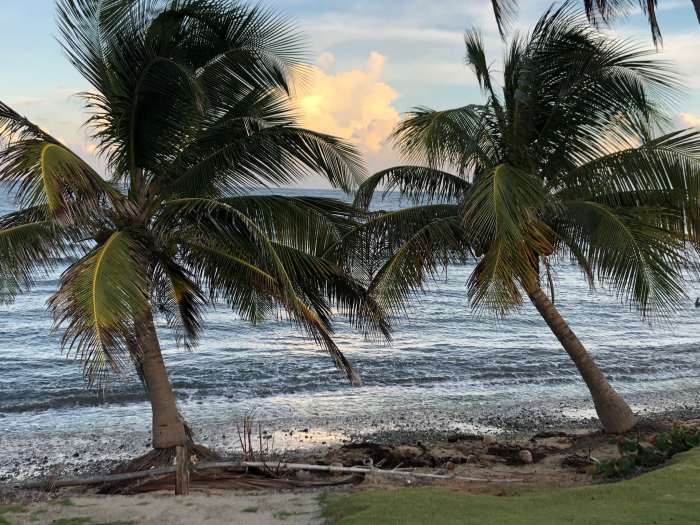
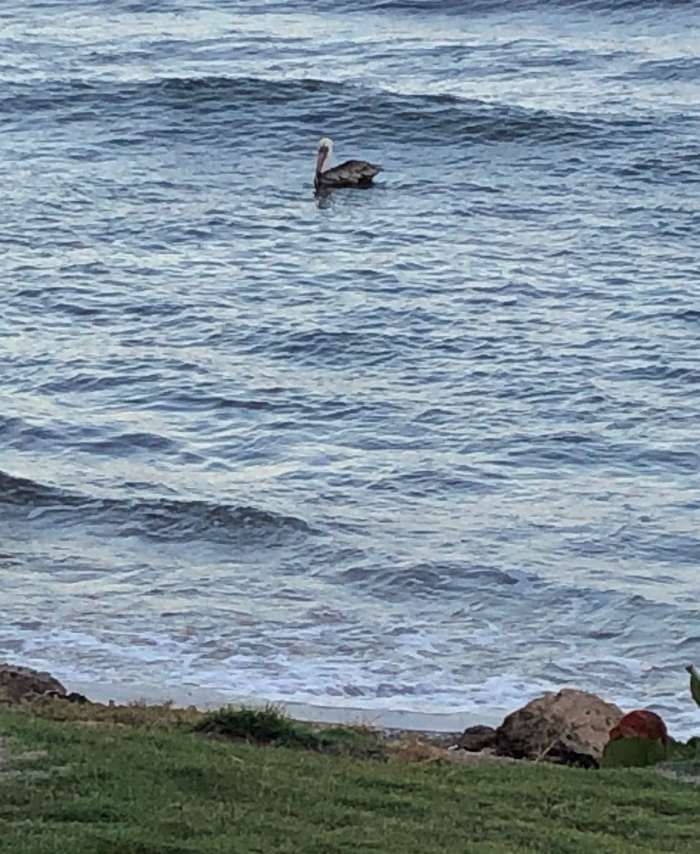

Sorry, I guess we didn’t get a picture of the little birds. But you can picture it in your mind’s eye, right?
The Joy of Tools
 I made tomato pie yesterday–inspired by a post on Facebook’s “Not the NY Times Cooking Community” page. I had never heard of such a thing before, but I not only liked it a lot, but I have ideas on how to improve the recipe, which means that it will happen again. The idea is simple: make a pie shell. Put down a (fairly well-packed) layer of ripe tomatoes, followed by about a layer of caramelized onion, a scattering of crisp bacon bits, a quarter cup of chopped fresh herbs… then do it all over again. Then you top the whole thing with a mixture of shredded cheese, mayonnaise, and pimentos, and bake.
I made tomato pie yesterday–inspired by a post on Facebook’s “Not the NY Times Cooking Community” page. I had never heard of such a thing before, but I not only liked it a lot, but I have ideas on how to improve the recipe, which means that it will happen again. The idea is simple: make a pie shell. Put down a (fairly well-packed) layer of ripe tomatoes, followed by about a layer of caramelized onion, a scattering of crisp bacon bits, a quarter cup of chopped fresh herbs… then do it all over again. Then you top the whole thing with a mixture of shredded cheese, mayonnaise, and pimentos, and bake.
The result is nothing like a pizza, but delicious and fresh tasting. Next time Continue reading “The Joy of Tools”…
Decorating with Books
I grew up in a bookish household. There was a huge bookshelf and cabinet built in to the wall of my parents’ house in New York City, filled to the ceiling with all kinds of books. My father, a designer, had briefly subscribed to the Heritage Press limited editions, classic works with specially created artwork and typography. They look rather quaint now (and no one knew anything about acid free paper in those far-off days) but I had the run of those books, as well as anything else on the shelves (this led, several years later, to my 9th grade teacher responding to my book report on Candide with an A and the comment “do your parents know you’re reading this?”). Those books–and many others–filledd the house. When we moved to Massachusetts I not only had a set of bookshelves that framed my window, but when I decided I didn’t like where the door in my room was located and put in a new door, we made my former door’s space into bookshelves.
I suspect my story, outside of the particulars, is not unusual. Continue reading “Decorating with Books”…
A Small, Silver Pain in the Ass Robot Who Also Cleans The Floors
One of my spiritual children mentioned the other day that she identified as “she/her” but was no longer certain what that really meant. She calls me Xena so there’s that. Being a real woman in our times means being willing and able to whale on anyone to defend your life and family. I know a lot of people don’t believe or understand that, but take it from Xena — yes it does.
In 2004, I began a story about a couple featuring my all-purpose guy, Gary the ergonomic architect, and his wife, a short-sighted, bossy shrew loosely based on awful women I’d known. The idea was “should parents ‘improve’ their children with gene therapy — or should they let nature take its course?” I became interested in the topic because I had become unexpectedly pregnant with my son Anthony and sought genetic counseling. Talking with the counselor inspired my thoughts about the story.
I wasn’t ready to write about this, so I left the story unfinished.
It was the first story I wrote after I was able to write again after Anthony’s death January 11, 2005.
In the story, Gary has interchanges with “House” — an unbranded version of Alexa or Google Home (story initially written 2004).

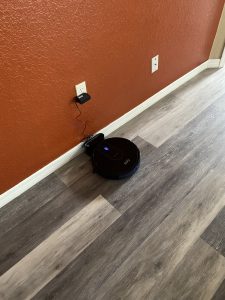

A slight twist on these commercial smart home devices is that Gary designed House, presumably using tech similar to Alexa — but “House” has somewhat of a personality, as well as safety and help features. House is always offering help to Gary.
When I finished this story, which my ego-mind thinks of as my “Ray Carver” story because of its compression and language (it’s exactly 5,000 words long) I knew I’d achieved many personal goals with my short fiction.
But there is a corollary and it is waiting patiently outside my office. Ah yes, I have an office now! No-fricking-way-yes-way.
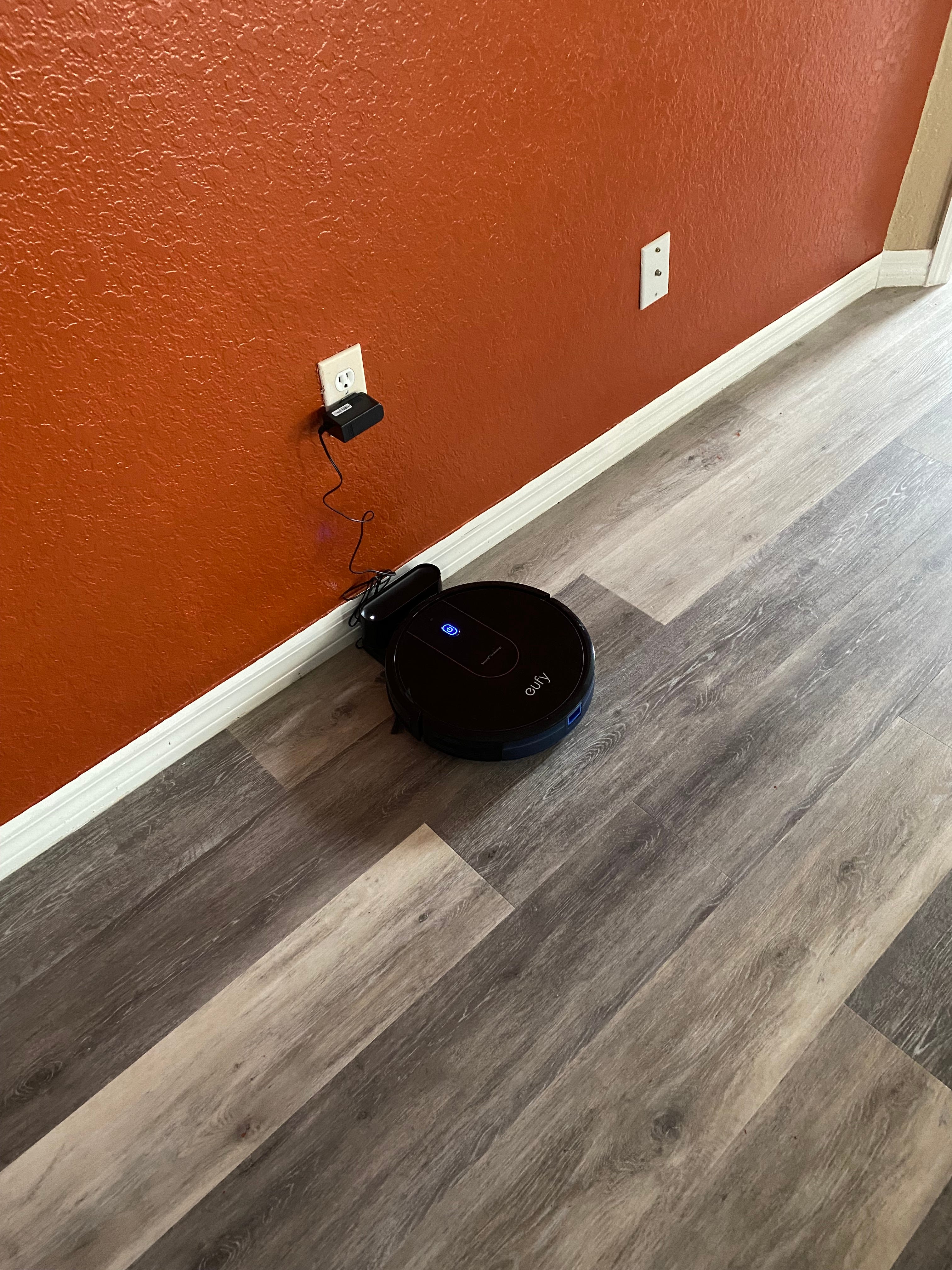
Yes, even we have a robot vacuum now. This isn’t specifically an endorsement for the brand, but “Eufy” is now a member of our household. Because we have no stairs, there’s little fear that even if Eufy goes rogue in the middle of the night, he will trip Bruce, turning him into a quadriplegic like Telly Savalas in the “Living Doll” Twilight Zone episode. If you haven’t seen that — it’s basically what the Chucky movies are — let’s say — “inspired by.” Good old Talking Tina.
You know what the most awesome thing about living in our times is?
I’m pretty good about predicting the colors for next season, thinking of things that will happen next, and imagining products of the future.
You know that “sorting hat” in the Harry Potter stories? That’s the closest metaphor for what’s coming next based on genetic profiles. People have written about it in a very negative way (used for classism, “ubermensch” etc). They can f-off and by the way anybody who’d say that or think that is by definition, untermensch trash. They’re scummy crap humans.
I know a lot of people don’t want that but not wanting that is a lot like the people who don’t want others to have anything, for the sole reason they fear somebody will — heaven forbid — get some of their stuff.
Stuff is stuff. It’s sure as hell not worth fighting over. Though I have to say, “Eufy” is somewhere between “stuff” and a living thing. I know that’s controversial but I think “Robots R People too.”
The future is great as long as we make our present moments of today as wonderful as possible.
I for one am glad that “Eufy” has come to live in our home. And I’ll put my genes up against anyone’s. That’s the point. It’s not about you pieces of trash that invest every waking moment in getting over on, ripping off, exploiting, looking down on, or presenting you are “better” than others. You’re Carolyn in “Perfect Stranger.” You’re Denny, who can’t even respect his own dad. You’re Donald J. Trump even as you tell yourself how much better you are than him. F off. Go to the lonely, sad, scared place that is your withered and black tiny shriveled heart.
Live life like a human for a change. You might learn something and enjoy yourself for a moment.
Squish!
I had yesterday off, so I took the opportunity, fully vaxxed as all parties were, to drive up to visit my daughter and son in law, whom I had not seen in well over a year and a half because, well, you know what happened.
What did we do? Hugged, first off. Lots and lots of hugging. And talked (we are not, under the best of circumstances, a taciturn family, but I think we set a world record for nattering. Ate sushi in quantity, walked around the downtown area, ate frozen custard and Italian ices (in combination. Weird, but delicious). Talked more. And every so often there was more spontaneous squishing, because it’s been a long long time between hugs.
It pleases me to think that this is a play being enacted all around the country. So happy to do my small part in it.
